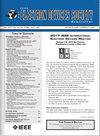增强型单二极管太阳能电池模型:利用Lambert W函数和电路创新的解析解
IF 2.4
3区 工程技术
Q3 ENGINEERING, ELECTRICAL & ELECTRONIC
引用次数: 0
摘要
本文重点介绍了在太阳能电池等效电路模型的创建和增强方面取得的重大进展。首先,提出了两种新的配置来改进经典的单二极管模型:一种是在端子连接之间增加一个二极管,另一种是在相同的端子之间串联插入一个二极管和电阻。其次,利用Lambert W函数推导出每个电路的电流-电压(I-V)特性的原始解析表达式。第三,在各种环境条件下对这些模型的性能进行了严格的评估。结果证明了模型的准确性和稳健性,均方根误差(RMSE)分析显示,与文献中现有的单二极管、双二极管和三二极管太阳能电池模型相比,模拟和实验的I-V曲线具有更好的一致性。最后,该方法提高了太阳能电池行为建模的数学精度,为优化太阳能系统提供了可靠的框架,有助于提高实际应用中的性能和效率。本文章由计算机程序翻译,如有差异,请以英文原文为准。
Enhanced Single-Diode Solar Cell Model: Analytical Solutions Using Lambert W Function and Circuit Innovations
This paper highlights significant advancements in the creation and enhancement of equivalent circuit models for solar cells. First, two novel configurations are proposed to enhance the classic single-diode model: one adds a diode between the terminal connections, while the other inserts a diode and resistor in series between the same terminals. Second, original analytical expressions for the current-voltage (I-V) characteristics of each proposed circuit are derived using the Lambert W function. Third, the performance of these models is rigorously evaluated on a variety of solar cells under diverse environmental conditions. Results demonstrated the models’ accuracy and robustness, with Root Mean Square Error (RMSE) analysis showing superior alignment between simulated and experimental I-V curves compared to existing single-, double-, and triple-diode solar cell models from the literature. Finally, the proposed approach enhances the mathematical precision in modeling solar cell behavior and provides a reliable framework for optimizing solar energy systems, contributing to improved performance and efficiency in practical applications.
求助全文
通过发布文献求助,成功后即可免费获取论文全文。
去求助
来源期刊

IEEE Journal of the Electron Devices Society
Biochemistry, Genetics and Molecular Biology-Biotechnology
CiteScore
5.20
自引率
4.30%
发文量
124
审稿时长
9 weeks
期刊介绍:
The IEEE Journal of the Electron Devices Society (J-EDS) is an open-access, fully electronic scientific journal publishing papers ranging from fundamental to applied research that are scientifically rigorous and relevant to electron devices. The J-EDS publishes original and significant contributions relating to the theory, modelling, design, performance, and reliability of electron and ion integrated circuit devices and interconnects, involving insulators, metals, organic materials, micro-plasmas, semiconductors, quantum-effect structures, vacuum devices, and emerging materials with applications in bioelectronics, biomedical electronics, computation, communications, displays, microelectromechanics, imaging, micro-actuators, nanodevices, optoelectronics, photovoltaics, power IC''s, and micro-sensors. Tutorial and review papers on these subjects are, also, published. And, occasionally special issues with a collection of papers on particular areas in more depth and breadth are, also, published. J-EDS publishes all papers that are judged to be technically valid and original.
 求助内容:
求助内容: 应助结果提醒方式:
应助结果提醒方式:


